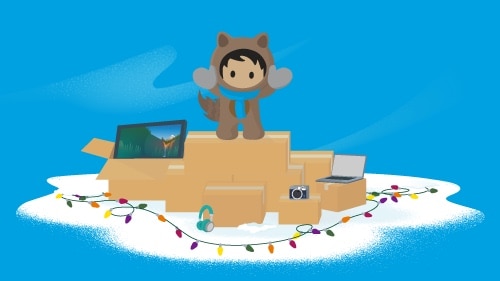As many retailers know, days like Thanksgiving, Black Friday, and Cyber Monday bring great holiday cheer, and they also bring the highest volume of customer touchpoints. In 2018, Salesforce powered over 20B emails during Cyber Week and nearly 600M push and SMS messages during Christmas and Boxing Week. Which means retailers need to provide next-level customer service, offer exceptional online and in-store experiences, and deliver timely, personalized messages at scale.
For this reason, we invited the best in the business, Best Buy, to offer some advice at Connections 2019. Zach Bezyak, Senior Manager of Marketing Technology and Operations at Best Buy, shared four tips to keep up with this increased holiday traffic and make sure everyone’s gifts arrive on time, so they don’t ruin Christmas morning — no one wants that.
Now, before we dive in, let’s all remember why we’re here. In Bezyak’s words, “Last year it [the holiday] was critical to our revenue for the year. So the stakes were very high and quality execution and great customer experiences became the foundation of our strategy.” Most retailers are in the same boat. So here are Best Buy’s tips for ensuring that the holiday shopping season goes off without a hitch.
1. Make a readiness plan
You may have already created a plan, but does it hit all the pain points? Bezyak elaborates, “The reason why a readiness plan is important is because it builds confidence in your org to deliver on your expectations.”
Think about the most critical functions and goals for your team? Here are a few examples:
- Online account management
- In-store experience
- Purchase updates
- Marketing KPIs
Next, determine the systems and teams involved. Are they aligned to the functions and goals above? Think about both internal and external teams and decide who owns ultimate accountability for each function. Be sure to identify failure points and bottlenecks. Are there system limitations that could possibly arise? Are there steps that exist where you can not move forward without limiting your speed?
Why is this important? Bezyak believes, “A password reset email is the most critical email we send. If the email is delayed, the customer may abandon that purchase and go and take their business elsewhere.”
2. Gain alignment
Now that you have a plan, ensure your stakeholders are aware and well versed. How can you do that? Hold a holiday kick-off meeting. Make it fun because, what’s more fun than the holidays? At Best Buy, they hold two meetings. One in June (it’s not too late to have one, just stop reading now and go set a calendar invite). This is the first kickoff and it covers the following agenda items:
- Does everyone agree with the critical functions and goals?
- Are all the right teams represented?
- Review the test plan – peak volumes, performance hogs, IPs, etc.
- Agree on the outcomes of these agenda items and document how your teams will communicate during issues
The second meeting is a little closer to the holiday. This is where the teams will dive a little deeper into their marketing plans. It’s a critical meeting to bring all the functions together one last time before the big show.
3. Test, test, test — and test some more
Bezyak made it pretty clear that testing is important in holiday readiness planning. This is the time to try out fresh new campaigns during other high traffic holidays like back-to-school or Labor Day. This will give you a great idea as to if you are fully holiday ready. Here are a few tips he shared:
- Make sure to test end-to-end
- Avoid “perfect world” tests unless you’re setting a baseline
- Watch for trends and document your failure points
- Set your goal above your expected peak volumes
- Always try to grow bigger and better each year
- Consider both API and batch sending across all of your channels
4. Execute the playbook
Now it’s time to put your plan into action.
Here are a few tips on how to execute:
- Not all missteps are created equal, so don’t react to them the same way
- Beware of hero mode and burnout — you’re in it for the long haul
- Establish meeting rhythms that make sense
- Create an after-hours, on-call rotation
- Align with business partners
- Set expectations with a reaction plan and turnaround
Now, always remember, stick to the playbook. You worked hard to create this. See it run its course. When it’s all said and done, hold a post-holiday debrief with your cross-functional teams. Discuss what worked and what didn’t, then make adjustments for the next year.
For more tips on how to get ready for the holiday season, check out our Holiday Readiness Guide.




























